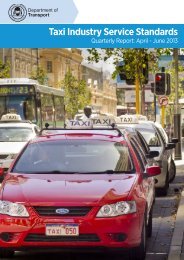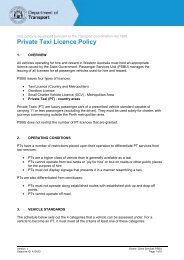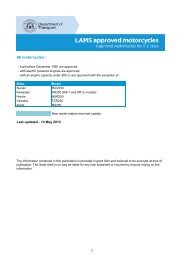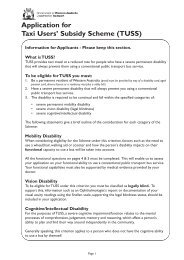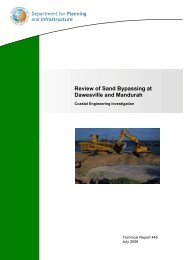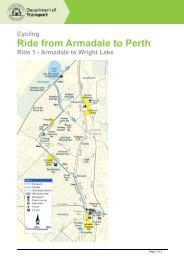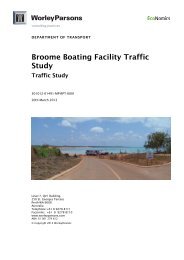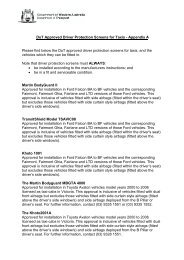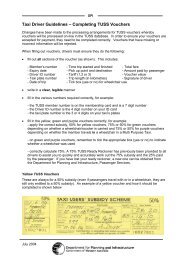Department of Transport Annual Report 2010 - 2011
Department of Transport Annual Report 2010 - 2011
Department of Transport Annual Report 2010 - 2011
Create successful ePaper yourself
Turn your PDF publications into a flip-book with our unique Google optimized e-Paper software.
37. Financial Instruments<br />
(a) Financial risk management objectives and policies<br />
Financial instruments held by the <strong>Department</strong> are cash and cash equivalents,<br />
restricted cash and cash equivalents, Treasurer’s advances and receivables and<br />
payables. The <strong>Department</strong> has limited exposure to financial risks. The <strong>Department</strong>’s<br />
overall risk management program focuses on managing the risks identified below.<br />
Credit risk<br />
Credit risk arises when there is the possibility <strong>of</strong> the <strong>Department</strong>’s receivables<br />
defaulting on their contractual obligations resulting in financial loss to the <strong>Department</strong>.<br />
The maximum exposure to credit risk at the end <strong>of</strong> the reporting period in relation<br />
to each class <strong>of</strong> recognised financial assets is the gross carrying amount <strong>of</strong> those<br />
assets inclusive <strong>of</strong> any provisions for impairment, as shown in the table at Note<br />
36(c) Financial instrument disclosures and Note 18 Receivables.<br />
Credit risk associated with the <strong>Department</strong>’s financial assets is minimal because<br />
the main receivable is the amounts receivable for services (holding account). For<br />
receivables other than government, the <strong>Department</strong> trades only with recognised,<br />
creditworthy third parties. The <strong>Department</strong> has policies in place to ensure that sales<br />
<strong>of</strong> products and services are made to customers with an appropriate credit history.<br />
In addition, receivable balances are monitored on an ongoing basis with the result<br />
that the <strong>Department</strong>’s exposure to bad debts is minimal. There were no significant<br />
concentrations <strong>of</strong> credit risk at the end <strong>of</strong> the reporting period.<br />
Allowance for impairment <strong>of</strong> financial assets is calculated based on objective<br />
evidence such as observable data indicating changes in client credit ratings. For<br />
financial assets that are either past due or impaired, refer to Note 36(c) Financial<br />
instrument disclosures and Note 18 Receivables.<br />
Liquidity risk<br />
Liquidity risk arises when the <strong>Department</strong> is unable to meet its financial obligations<br />
as they fall due. The <strong>Department</strong> is exposed to liquidity risk through its trading in<br />
the normal course <strong>of</strong> business.<br />
The <strong>Department</strong> has appropriate procedures to manage cash flows including<br />
drawdowns <strong>of</strong> appropriations by monitoring forecast cash flows to ensure that<br />
sufficient funds are available to meet its commitments.<br />
Market risk<br />
Market risk is the risk that changes in market prices such as foreign exchange rates<br />
and interest rates will affect the <strong>Department</strong>’s income or the value <strong>of</strong> its holdings <strong>of</strong><br />
financial instruments. The <strong>Department</strong> does not trade in foreign currency and is not<br />
materially exposed to other price risks (for example, equity securities or commodity<br />
prices changes).<br />
Other than as detailed in the interest rate sensitivity analysis table at note 36(c)<br />
Financial instrument disclosures. The <strong>Department</strong> is not exposed to interest rate<br />
risk because apart from minor amounts <strong>of</strong> restricted cash, all other cash and cash<br />
equivalents and restricted cash are non-interest bearing, and have no borrowings<br />
other than the Treasurer’s advance (non-interest bearing).<br />
(b) Categories <strong>of</strong> Financial instruments<br />
<strong>2011</strong><br />
$ 000<br />
<strong>2010</strong><br />
$ 000<br />
Financial Assets<br />
Cash and cash equivalents 27 122 26 663<br />
Restricted cash and cash equivalents 65 092 44 591<br />
Receivables (i) - 4 661<br />
Amounts receivable for services 122 031 107 234<br />
Total Financial Assets 214 245 183 149<br />
Financial Liabilities<br />
Payables 10 219 8 379<br />
Finance lease liabilities 47 -<br />
Total Financial Assets 10 266 8 379<br />
(i) The amount <strong>of</strong> receivables excludes GST recoverable from the ATO (statutory receivable).<br />
83



